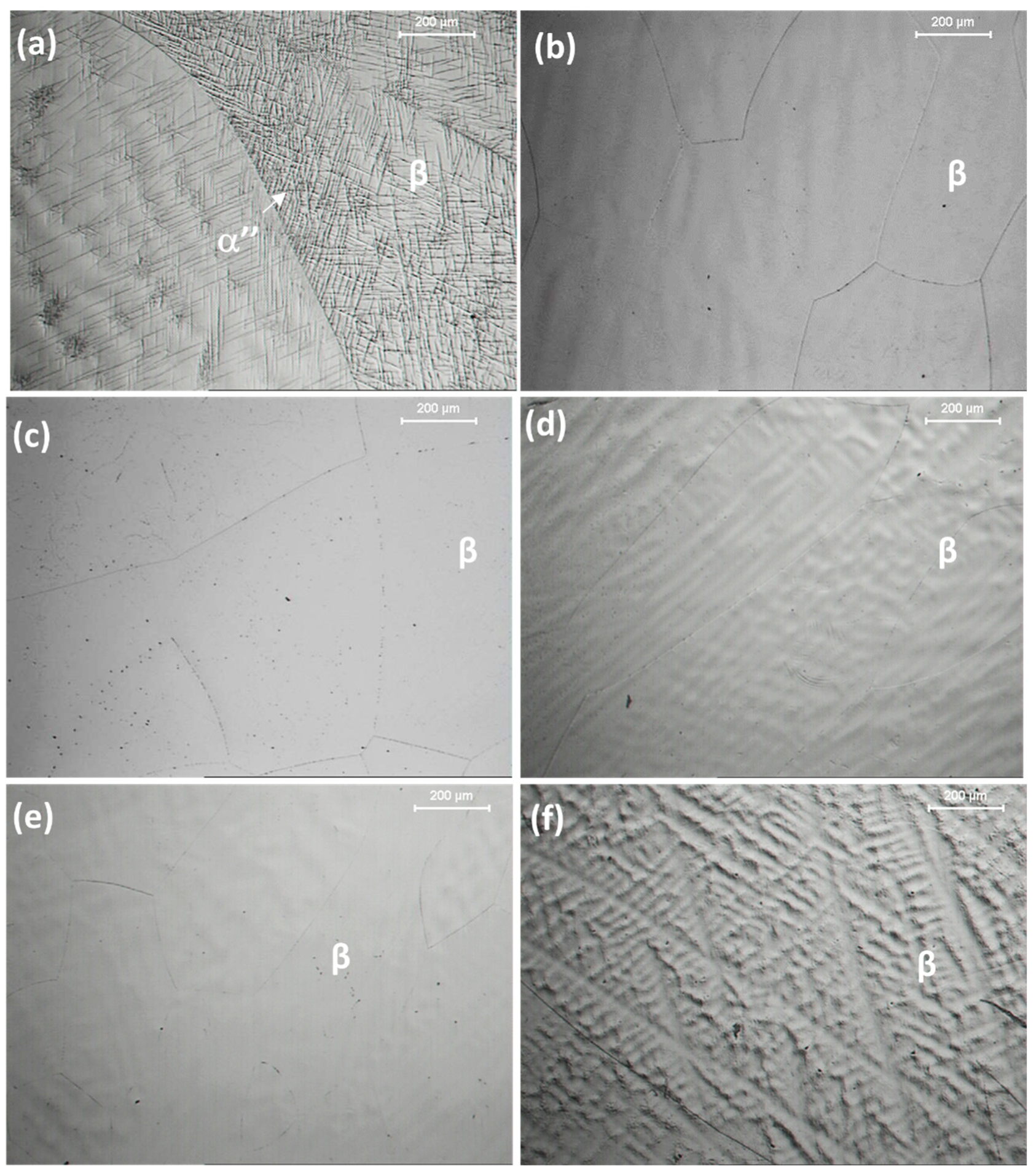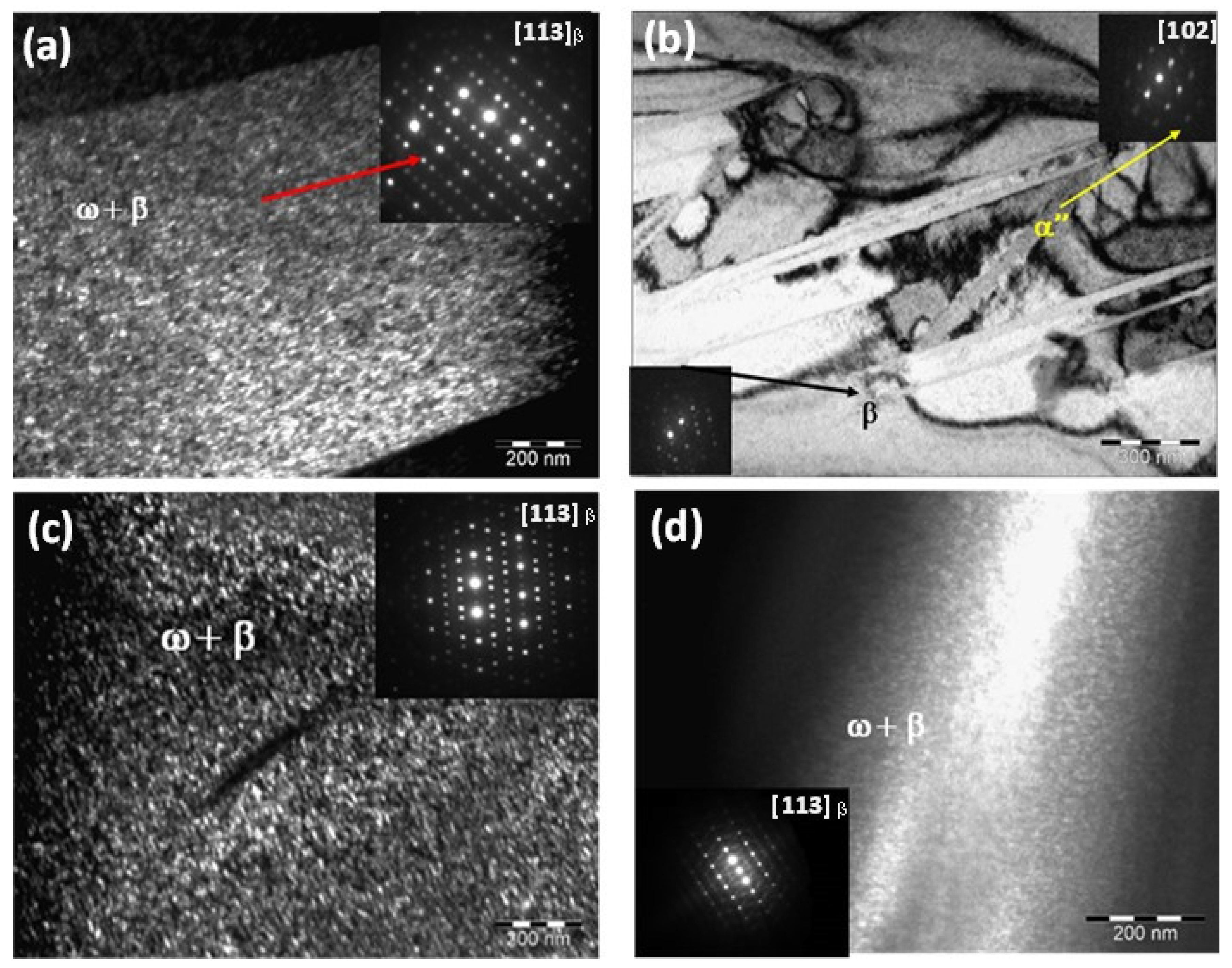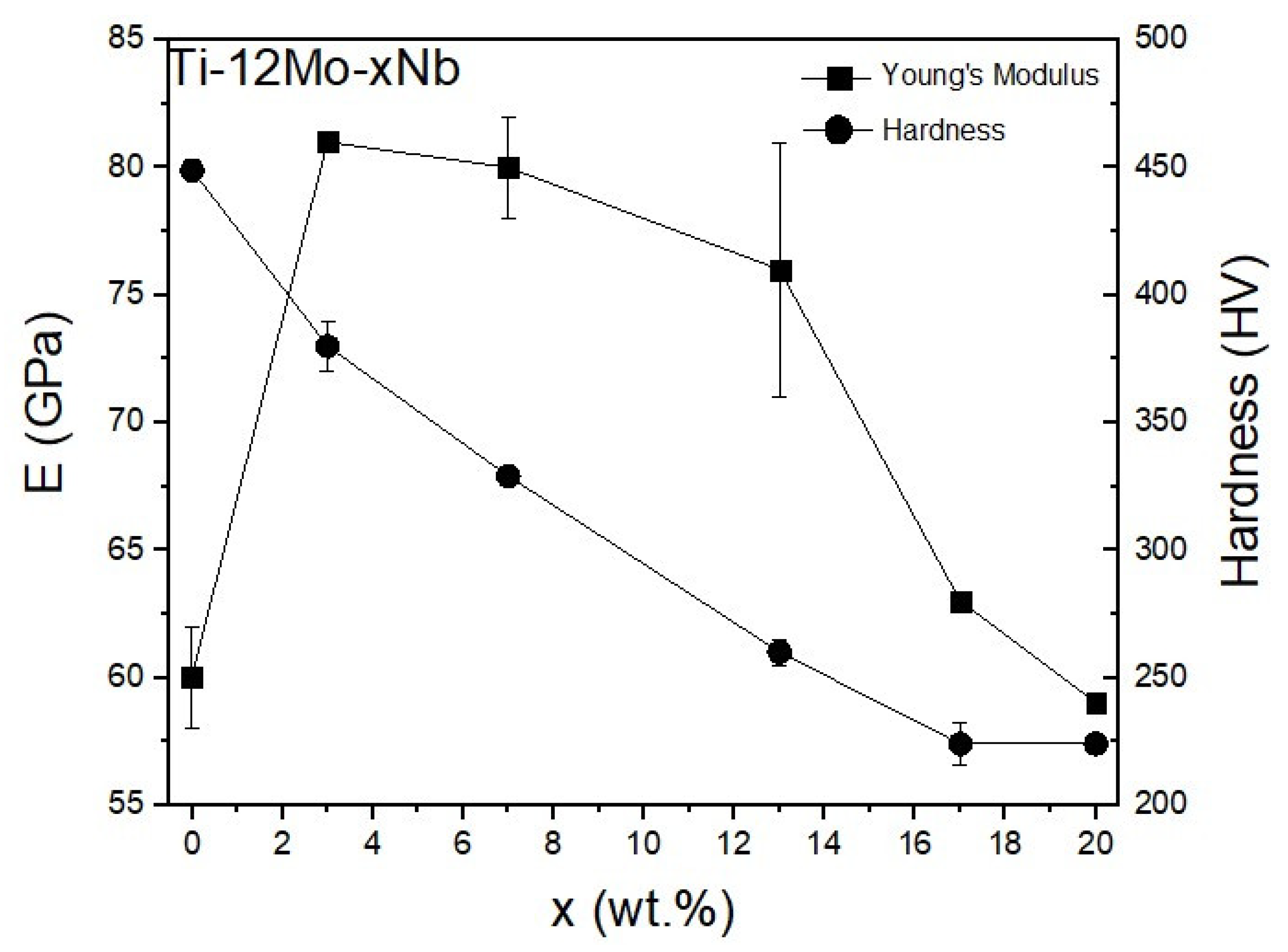Influence of Nb Addition on α″ and ω Phase Stability and on Mechanical Properties in the Ti-12Mo-xNb Stoichiometric System
Abstract
:1. Introduction
2. Materials and Methods
3. Results and Discussion
4. Conclusions
Author Contributions
Funding
Data Availability Statement
Acknowledgments
Conflicts of Interest
References
- Chui, P.; Jing, R.; Zhang, F.; Li, J.; Feng, T. Mechanical properties and corrosion behavior of β–type Ti–Zr–Nb–Mo alloys for biomedical application. J. Alloy. Compd. 2020, 842, 155693. [Google Scholar] [CrossRef]
- Bania, P.J. Beta titanium alloys and their role in the titanium industry. J. Miner. Met. Mater. Soc. 1994, 46, 16–19. [Google Scholar] [CrossRef]
- Xu, W.; Hou, C.; Mao, Y.; Yang, L.; Tamaddon, M.; Zhang, J.; Qu, X.; Liu, C.; Su, B.; Lu, X. Characteristics of novel Ti–10Mo–xCu alloy by powder metallurgy for potencial biomedical implant applications. Bioact. Mater. 2020, 5, 659–666. [Google Scholar] [CrossRef] [PubMed]
- Kalita, D.; Rogal, T.; Czeppe, T.; Wójcik, A.; Kolano-Burian, A.; Zackiewicz, P.; Kania, B.; Dutkiewicz, J. Microstructure and Mechanical Properties of Ti-Nb Alloys Prepared by Mechanical Alloying and Spark Plasma Sintering. J. Mater. Eng. Perform. 2020, 29, 1445–1452. [Google Scholar] [CrossRef]
- Laheurte, P.; Prima, F.; Eberhardt, A.; Gloriant, T.; Wary, M.; Patoor, E. Mechanical properties of low modulus titanium alloys designed from the electronic approach. J. Mech. Behav. Biomed. Mater. 2010, 3, 565–573. [Google Scholar] [CrossRef] [PubMed]
- Xu, J.L.; Chen, Y.Y.; Liu, Z.G.; Kong, F.T. The microstructure and properties of Ti–Mo–Nb alloys for biomedical application. J. Alloy. Compd. 2008, 453, 320–324. [Google Scholar] [CrossRef]
- Gabriel, S.B.; Dille, J.; Nunes, C.A.; Soares, G.A. The effect of niobium content on the hardness and elastic modulus of heat–treated Ti–10Mo–xNb alloys. Mater. Res. 2010, 13, 333–337. [Google Scholar] [CrossRef]
- Joint Committee on Powder Diffraction Standard (JCPDS). International Centre for Diffraction Data; JCPDS: Swarthmore, PA, USA, 2004. [Google Scholar]
- American Society for Testing Materials (ASTM). E92-17-Standard Test Methods for Vickers Hardness and Knoop Hardness of Materials Metallics; ASTM International: West Conshohocken, PA, USA, 2017. [Google Scholar]
- American Society for Testing Materials (ASTM). E384-17-Standard Test Method for Microindentation Hardness of Materials; ASTM International: West Conshohocken, PA, USA, 2017. [Google Scholar]
- Niinomi, M. Recent research and development in titanium alloys for biomedical applications and healthcare goods. Sci. Technol. Adv. Mater. 2003, 4, 445–454. [Google Scholar] [CrossRef]
- American Society for Testing Materials (ASTM). E1876-09—Standard Test Method for Dynamic Young’s Modulus, Shear Modulus, and Poisson’s Ratio by Impulse Excitation of Vibration; ASTM International: West Conshohocken, PA, USA, 2017. [Google Scholar]
- Moshokoa, N.; Raganya, L.; Obadele, B.A.; Machaka, R.; Makhatha, M.E. Microstructural and mechanical properties of Ti-Mo alloys designed by the cluster plus glue atom model for biomedical application. Int. J. Adv. Manuf. Technol. 2020, 111, 1237–1246. [Google Scholar] [CrossRef]
- Matsumoto, H.; Watanabe, S.; Hanada, S. Microstructures and mechanical properties of metastable β TiNbSn alloys cold rolled and heat treated. J. Alloy. Compd. 2007, 439, 146–155. [Google Scholar] [CrossRef]
- Yao, T.; Du, K.; Wang, H.; Huang, Z.; Li, C.; Li, L.; Hao, Y.; Yang, R.; Ye, H. In situ scanning and transmission electron microscopy investigation on plastic deformation in a metastable β titanium alloy. Acta Mater. 2017, 133, 21–29. [Google Scholar] [CrossRef]
- Jawed, S.F.; Rabadia, C.D.; Liu, Y.J.; Wang, L.Q.; Li, Y.H.; Zhang, X.H.; Zhang, L.C. Mechanical characterization and deformation behavior of β-stabilized Ti-Nb-Sn-Cr alloys. J. Alloy. Compd. 2019, 792, 684–693. [Google Scholar] [CrossRef]
- Zhang, P.; Li, S.X.; Zhang, Z.F. General relationship between strength and hardness. Mater. Sci. Eng. C 2011, 529, 62–73. [Google Scholar] [CrossRef]
- Hsu, H.C.; Wong, K.K.; Wu, S.C.; Chen, Y.X.; Ho, W.F. Metastable dual-phase Ti–Nb–Sn–Zr and Ti–Nb–Sn–Fe alloys with high strength-to-modulus ratio. Mater. Today Commun. 2022, 30, 103168. [Google Scholar] [CrossRef]
- Xu, Y.; Liu, H.; Zhang, S.; Xiong, H. Effect of duplex aging on microstructural and mechanical behavior of a new β-Ti alloy for biomedical applications, J. Mater. Res. Technol. 2022, 18, 2870–2884. [Google Scholar] [CrossRef]
- Gabriel, S.B.; de Almeida, L.H.; Nunes, C.A.; Dille, J.; Soares, G.A. Maximisation of the ratio of microhardness to the Young’s modulus of Ti–12Mo–13Nb alloy through microstructure changes. Mater. Sci. Eng. C 2013, 33, 3319–3324. [Google Scholar] [CrossRef]
- Panigrahi, A.; Bönisch, M.; Waitz, T.; Schafler, E.; Calin, M.; Eckert, J.; Skrotzki, W.; Zehetbauer, M. Phase transformations and mechanical properties of biocompatible Ti–16.1Nb processed by severe plastic deformation. J. Alloy. Compd. 2015, 628, 434–441. [Google Scholar] [CrossRef]
- Li, M.; Min, X.; Yao, K.; Ye, F. Novel insight into the formation of α″-martensite and ω-phase with cluster structure in metastable Ti-Mo alloys. Acta Mater. 2019, 164, 322–333. [Google Scholar] [CrossRef]
- Ji, P.; Chen, B.; Li, B.; Tang, Y.; Zhang, G.; Zhang, X.; Ma, M.; Liu, R. Influence of Nb addition on microstructural evolution and compression mechanical properties of Ti-Zr alloys. J. Mater. Sci. Technol. 2021, 69, 7–14. [Google Scholar] [CrossRef]
- Hao, Y.L.; Yang, R.M.; Kuroda, D.; Zhou, Y.L.; Fukunaga, K.; Suzuki, A. Young’s modulus and mechanical properties of Ti-29Nb-13Ta-4.6 Zr in relation to α″ martensite. Metall. Mater. Trans. A 2002, 33, 3137–3144. [Google Scholar] [CrossRef]




| Alloys | Hardness (HV) | Young’s Modulus (GPa) | Phases | Ratio (Hardness/Modulus) |
|---|---|---|---|---|
| Ti-6Al-4V ELI WQ | 346 | 118 | α + β | 2.9 |
| Ti–12Mo | 449 ± 4 | 60.0 ± 1.8 | α″ + ω + β | 7.5 |
| Ti–12Mo–3Nb | 380 ± 10 | 81.0 ± 0.3 | ω + β | 4.7 |
| Ti–12Mo–7Nb | 329 ± 3 | 80.0 ± 1.5 | ω + β | 4.1 |
| Ti–12Mo–13Nb | 260 ± 5 | 76.0 ± 4.9 | ω + β | 3.4 |
| Ti–12Mo–17Nb | 224 ± 8 | 59.0 ± 0.4 | ω + β | 3.5 |
| Ti–12Mo–20Nb | 224 ± 2 | 63.0 ± 0.2 | ω + β | 3.8 |
Publisher’s Note: MDPI stays neutral with regard to jurisdictional claims in published maps and institutional affiliations. |
© 2022 by the authors. Licensee MDPI, Basel, Switzerland. This article is an open access article distributed under the terms and conditions of the Creative Commons Attribution (CC BY) license (https://creativecommons.org/licenses/by/4.0/).
Share and Cite
Borborema, S.; de Holanda Ferrer, V.; Rocha, A.d.C.; Cossú, C.M.F.A.; Nunes, A.R.V.; Nunes, C.A.; Malet, L.; de Almeida, L.H. Influence of Nb Addition on α″ and ω Phase Stability and on Mechanical Properties in the Ti-12Mo-xNb Stoichiometric System. Metals 2022, 12, 1508. https://doi.org/10.3390/met12091508
Borborema S, de Holanda Ferrer V, Rocha AdC, Cossú CMFA, Nunes ARV, Nunes CA, Malet L, de Almeida LH. Influence of Nb Addition on α″ and ω Phase Stability and on Mechanical Properties in the Ti-12Mo-xNb Stoichiometric System. Metals. 2022; 12(9):1508. https://doi.org/10.3390/met12091508
Chicago/Turabian StyleBorborema, Sinara, Vitor de Holanda Ferrer, Adriana da Cunha Rocha, Caio Marcello Felbinger Azevedo Cossú, Aline Raquel Vieira Nunes, Carlos Angelo Nunes, Loic Malet, and Luiz Henrique de Almeida. 2022. "Influence of Nb Addition on α″ and ω Phase Stability and on Mechanical Properties in the Ti-12Mo-xNb Stoichiometric System" Metals 12, no. 9: 1508. https://doi.org/10.3390/met12091508
APA StyleBorborema, S., de Holanda Ferrer, V., Rocha, A. d. C., Cossú, C. M. F. A., Nunes, A. R. V., Nunes, C. A., Malet, L., & de Almeida, L. H. (2022). Influence of Nb Addition on α″ and ω Phase Stability and on Mechanical Properties in the Ti-12Mo-xNb Stoichiometric System. Metals, 12(9), 1508. https://doi.org/10.3390/met12091508







